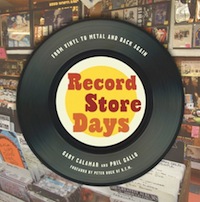There Was a Time

Before compact discs, before cassette tapes, before eight-track tapes, there was a playback medium called the long-playing record. It was a 12-inch disc (there were also seven-inch discs called “singles”) made of black vinyl (although occasionally they were colored differently). They were encased in a “jacket cover,” which exhibited artwork and information of various levels of relevance and usefulness. These records were played back on a revolving platter with a perpendicular tube that had a needle or stylus affixed that tracked along the record’s grooves. These were susceptible to varieties of damage, but the L.P. was in the main a dependable medium of music storage and reproduction prior to the digital era.
Concomitant with the post WWII rise in popularity of music culture and pop music was the evolution of the record store from mere departments at various retailers to the dedicated and sometimes specialty merchants. Gary Calamar and Phil Gallo, who are music business veterans, celebrate these once-endangered institutions with a paean entitled Record Store Days: From Vinyl to Metal and Back Again (Sterling Publishing). They explain:
Record stores came of age in the late 1960s, a time when America was in a state of revolution. The underground music stores that sprang up in New York, San Francisco, and Los Angeles became models for stores in cities and towns across the country. By the early ‘70s, no matter where you were, the record store was the coolest place on the block. In some instance it was the bootlegs, and in other cases it may have been the bongs, but ultimately, it was the passion for the music that keep the people coming… Stories included here are unique in their specifics but universal in their generality… Record-buying conjures so many shared memories, it feels as if it had once been a ritual for all the practitioners: searching the cutout bins and used shops for bargains; dropping in a hip store daily to inquire about new releases; finding the import specialist, taking the advice of the clerk, and buying that record he or she insists you just must have.
Apparently, vinyl is making a comeback—at least some (really fussy) audio aficionados claim its superiority. And there is, of course, the elevation of album cover art to something both notable and collectible. Also, there is another view that is expressed by the venerable Tom Waits: “Folks who work here are professors. Don’t replace all the knowers with the guessers. Keep ‘em open—they’re the ears of the town.”
